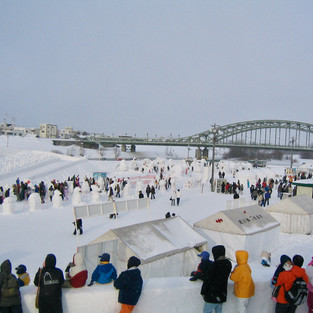Let it snow ......... Japan's Yuki Matsuri
- Saizen Tours

- Feb 28, 2021
- 6 min read

Let it snow, let it snow, let it snow ........ February is the month for Japan's famous Snow Festivals (Yuki Matsuri 雪祭り). Of course I realise the majority of teachers find it impossible to travel to Japan in February. However if you do get the opportunity then the snow festivals are a must see and have on your Japan bucket list! I have been to quite a few snow festivals in Hokkaido over the past years and the experience is always unique and enjoyable. Japan's northernmost island is blanketed in pure white snow, ice sculptures glisten and trees twinkle with lights. Huge snow sculptures and festival activities are found in a number of cities throughout Hokkaido, usually commencing the first week of February. Rug up in warm clothes, scarves and gloves and then step out during both the day and night to enjoy the festivals, food and entertainment!

ACCESS AND TRANSPORTATION
You can travel easily to Sapporo from Tokyo by land or air.
By air – there are a few low-cost domestic airlines as well as full-service airlines providing almost hourly flights from Tokyo plus direct flights from regional cities - Japan Airlines, All Nippon Airways Peach Aviation, Air Do and Jetstar Japan to name a few.
Regional air passes can be purchased for economical fares. Qantas Airways has recently operated Sydney to Sapporo direct flights during the winter season and hopefully these flights will continue.
By train – in 2016 the Hokkaido Shinkansen opened to link Aomori on Japan’s main island of Honshu to Hakodate on the island of Hokkaido. From Tokyo to Shin-Hakodate-Hokuto the train trip takes 4 hours. Then transfer to the Hokuto Limited Express to Sapporo which takes a further 3.5 hours. The entire one-way trip costs around 29,000 yen and takes around eight hours. It is fully covered by the Japan Rail Pass and JR East South Hokkaido Rail Pass. Once you arrive in Hokkaido you can continue to use your valid JR Pass or purchase a regional JR Hokkaido Pass (3-day ¥17,400, 5-day ¥23,480, 7-day ¥25,710, 4-day Flexible ¥23,480).
Getting around Sapporo is easy to navigate as Sapporo is well laid out with a rectangular street grid. City blocks are named and numbered according to compass points. There are three subway lines servicing the city plus three bus companies. The Japan Rail Pass, Hokkaido Rail Pass and Hokkaido Free Pass are all valid to use on the local buses operated by the JR Hokkaido Bus company.

SAPPORO YUKI MATSURI ~ 札幌雪祭り
The Sapporo Yuki Matsuri (Sapporo Snow Festival) is held in the first week of February and runs for seven days. It is held in three distinct areas - Odori Park, Susukino and Tsudome.
Traditionally there has always been regional snow festivals in Hokkaido however these were stopped during WWII. In 1950 six local high school students built six snow statues in Odori Park and the Sapporo Festival began again as a one-day event. In 1955 soldiers from the Japan Self-Defence Forces at the nearby Makomanai Base joined in and built the first gigantic snow sculptures. Makomanai continued as one of the three main sites in Sapporo until this part of the festival was moved to its present site at Tsudome in 2009. In 1974 the International Snow Statue Competition commenced with 14 teams from around the world.
Unfortunately this year's 2021 Yuki Matsuri has been cancelled to prevent the spread of coronavirus. However it is being featured as an online event https://online.snowfes.com/en/

Odori Park is situated in the heart of Sapporo and divides the city into north and south. It is a long 1.5km park flanked by the Sapporo TV Tower which offers great views of the park and snow sculptures. The park features huge snow sculptures, an ice skating rink, ice slides, entertainment and many food stalls.

Susukino site is known as the Susukino Ice Festival. It showcases a long stretch of ice sculptures, Illumination Street, ice bars, food and entertainment. It is easily reached by subway or through the underground station walkways. Each year the Susukino Queen of Ice is crowned at the festival.

Sapporo Community Dome is known simply as Tsudome. It is located on the outskirts of Sapporo in Higashi-ku district. There is a large carpark and the nearest train station is Sakaemachi Station. Tsudome was chosen due to its spacious area with this site of the festival offering fun activities such as large snow slides and snow raft rides. The large dome hall has many food outlets and other inside activities.

ASAHIKAWA FUYU MATSURI ~ 旭川冬祭り
After an enjoyable week in Sapporo my next destination is always to Asahikawa for the Asahikawa Winter Festival (Asahikawa Fuyu Matsuri). Limited Express trains depart from JR Sapporo Station to JR Asahikawa Station every half hour and will get you to Asahikawa in 85 minutes. Both budget and more expensive accommodation are easily accessible and within walking distance from Asahikawa Station. The Asahikawa Fuyu Matsuri is a much loved local festival, devoid of the multitude of overseas travellers that flock to Sapporo's festival. It is held in conjunction with Sapporo's so can be conveniently included in your itinerary.
The festival consists of two main sites - the Heiwa Dori Site and Asahibashi Site. Heiwa Dori is the pedestrian street that runs approximately one kilometer from Asahikawa Station to the vicinity of the Asahibashi Site. There are also free shuttle buses from the station to the Asahibashi Site, departing approximately every 20 minutes.

Heiwa Dori was opened in 1972. It is Japan's first permanent pedestrian-only street extending around 1km to the north from near Asahikawa Station. The shopping street is tree lined with many unique shops and various sculptures. Heiwa Dori has a system that melts the snow on the pedestrian street so navigating the outdoor shopping mall is easy. About 50 ice sculptures are displayed along the street and are judged in an ice sculpture competition. For the first few days of the festival the sculptors can be seen at work, after which the sculptures are left on display. The sculptures are illuminated at night so are enjoyable during the day and particularly pretty in the evening.

Asahikawa may not be Hokkaido's biggest winter festival but it certainly can boast having one of the biggest snow sculptures. Every year at the Asahibashi Site a massive snow sculpture is made as a stage for music and other performances. Giant sculptures line the riverbank with a different theme each year. Taiko drums sound out from the giant stage, music, dancing, festival food, horse drawn sleighs, snow slides and the impressive backdrop of Asahibashi Bridge all combine for an enjoyable day in the snow!

SŌUNKYŌ ONSEN HYOBAKU MATSURI ~ 層雲峡温泉 氷瀑祭り
My most favourite winter festival is the Sōunkyō Onsen Hyobaku Matsuri (Sōunkyō Hot Spring Ice Waterfall Festival). Sōunkyō is an onsen resort town situated in a scenic gorge north of the Daisetsuzan National Park. In summer it is a popular hiking area, flanked by tall mountains and waterfalls. Most of the accommodation has both indoor and outdoor rotenburo hot spring baths with a large segregated onsen in the town’s center.
From Asahikawa Station there is a direct bus to Sōunkyō. The bus departs every 1 to 2 hours and costs approximately ¥2,140 one way. The journey takes two hours, however I have been on the bus during a blizzard and it took a lot longer due to frequent stops!
The Ice Waterfall Festival runs from late January to mid-March (January 30 to March 14, 2021). The snow sculptures change each year but the general layout features a gigantic ice ‘castle’ with a large interior cavern and maze that you can walk through. Ice lanterns line the streets and are lit up at night with a fireworks display on most weekends. I can highly recommend this special experience of walking the illuminated streets early evening as the snow falls around you, watching the fireworks and then returning to your ryokan to warm up in a hot, steaming outdoor rotenburo onsen!

OTARU YUKI AKARI NO MICHI ~ 小樽雪あかりの路
Lastly, for something different, you can take the train from Sapporo to Otaru and visit the Otaru Yuki Akari No Michi (Otaru Snow Light Path Festival). Otaru is a small harbour city with a beautifully preserved canal district and historical buildings, situated northwest of Sapporo City. Both the Otaru festival and the Sapporo festival are held at the same time so it is possible to make a day trip from Sapporo and stay in Otaru for the evening to enjoy the night illuminations.
Access is by train from JR Sapporo Station to JR Otaru Station. The rapid train departs regularly and takes about 35 minutes. It is then a short 10 minute walk to the Snow Light Path area.
The main illuminated area is along the canal which is lit up with snow sculptures, lanterns along the entire canal length and floating candles. There are many tourist shops and restaurants that specialise in local seafood.
If you can't get to the snow festivals in February you can still enjoy the winter snow from late November to early April depending on the area. We can organise trips to the ski fields with lessons and all the gear needed for skiing or snowboarding including ski jackets and pants. School groups can enjoy cherry blossoms as well as the snow in March/April. A popular place to visit with students year round are the snow monkeys in Nagano. So rug up, put on your smile, warm gloves and beanies and enjoy!!

Some people love the snow and some just don't like the cold!!

Written by Rondell Herriot, Co-Managing Director Saizen Tours
Stay up to date with us on Facebook and our Website:
















Comentarios